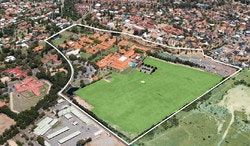Year 11 English ATAR
This course is designed for students who wish to study English ATAR in Year 12 and sit a WACE English examination at the end of Year 12 to gain university entrance. English ATAR is a difficult course and requires application of theory to textual analysis.
The English ATAR course focuses on developing students' analytical, creative and critical thinking and communication skills in all language modes. It encourages students to critically engage with texts from their contemporary world, with texts from the past and with texts from Australian and other cultures. Such engagement helps students develop a sense of themselves, their world and their place in it.
Through close study and wide reading, viewing and listening, students develop the ability to analyse and evaluate the purpose, stylistic qualities and conventions of texts and enjoy creating their own imaginative, interpretive, persuasive and analytical responses. The English ATAR course is designed to develop students' facility with all types of texts and language modes and to foster an appreciation of the value of English for lifelong learning.
Students refine their skills across all language modes by engaging critically and creatively with texts. They learn to speak and write fluently in a range of contexts and to create a range of text forms. They hone their oral communication skills through discussion, debate and argument, in a range of formal and informal situations.
Unit 1
Students explore how meaning is communicated through the relationships between language, text, purpose, context and audience. This includes how language and texts are shaped by their purpose, the audiences for whom they are intended and the contexts in which they are created and received. Through responding to and creating texts, students consider how language, structure and conventions operate in a variety of imaginative, interpretive and persuasive texts. Study in this unit focuses on the similarities and differences between texts and how visual elements combine with spoken and written elements to create meaning. Students develop an understanding of stylistic features and apply skills of analysis and creativity. They are able to respond to texts in a variety of ways, creating their own texts, and reflecting on their own learning.
Unit 2
Students analyse the representation of ideas, attitudes and voices in texts to consider how texts represent the world and human experience. Analysis of how language and structural choices shape perspectives in and for a range of contexts is central to this unit. By responding to and creating texts in different modes and media, students consider the interplay of imaginative, interpretive, persuasive and analytical elements in a range of texts and present their own analyses. Students critically examine the effect of stylistic choices and the ways in which these choices position audiences for particular purposes, revealing and/or shaping attitudes, values and perspectives. Through the creation of their own texts, students are encouraged to reflect on their language choices and consider why they have represented ideas in particular ways.
Assessment
The following types of assessments and weightings will be undertaken:
Responding: 35% | Creating: 35% | Examination: 30%
Examinations will take place at the end of Semesters One and Two and will cover key content of the unit or units covered in that semester.
Reporting
The achievement for the unit will be reported as a College A - E grade. In addition, the student's approach to class work and behaviour will be reported via the usual key performance indicators.
Student Expectations/Homework
Students will be expected to complete approximately 2.5 hours of homework each week. This time should be spent consolidating material covered in class as well as any assigned tasks.
